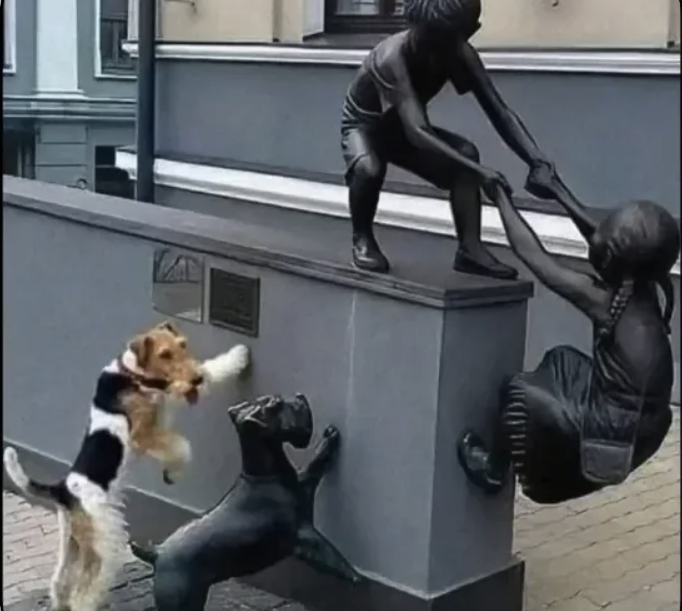
She was just walking past it—a bronze sculpture in the middle of the street depicting three figures frozen in a moment of teamwork. A child reaching down, a dog jumping up, another child pulling from below, all working together in silent cooperation. It was the kind of public art people pass every day without really seeing, beautiful in theory but static in reality. Until a real dog decided otherwise.
The passerby noticed him first—a scruffy terrier mix with cream and brown patches, trotting confidently toward the sculpture as if he’d been summoned. No owner called out. No leash held him back. He simply approached the bronze figures with purpose, studying them for a brief moment before making his move. Then, without hesitation, he jumped.
His front paws landed perfectly on the sculpture’s base, right beside the bronze dog already frozen there. He stretched upward, nose lifted toward the child’s outstretched hand, matching the pose with uncanny precision. For a few magical seconds, art and life became indistinguishable. Four figures working together—three made of metal, one made of fur and beating heart—all reaching toward something just beyond their grasp.
The woman watching felt her breath catch. She fumbled for her phone, knowing this moment wouldn’t last but needing to capture it anyway. The dog held his position like he understood the assignment, like he’d seen the sculpture and thought, they need help, and I’m here to help. There was no confusion in his eyes, no hesitation in his stance. Just pure, spontaneous participation in something beautiful.
What made the moment extraordinary wasn’t just the visual perfection of it—though that alone was stunning—but what it represented. Here was a dog who saw figures reaching and decided to reach with them. Who saw cooperation frozen in bronze and chose to make it living. Who looked at art depicting the best of what we can be and said, yes, I’m part of this too.
The woman thought about how often we walk past beauty without engaging with it. How we see sculpture and painting and poetry as things to observe from a distance, appreciate intellectually, but never truly join. This dog had no such barriers. He saw helping and wanted to help. He saw connection and chose to connect. He transformed a static monument into a living reminder that kindness is contagious, even across the boundary between art and life.
After a moment, the dog dropped back down to all fours, gave the sculpture one last look, and trotted away as casually as he’d arrived. No fanfare, no expectation of applause. He’d done what he came to do—joined in, added his presence to the scene, reminded everyone watching that the best art doesn’t just depict life, it invites us to participate in it.
The woman looked at the photo on her phone, this perfect collision of intention and accident, permanence and spontaneity. She thought about posting it, about sharing this moment of pure magic with others who might need reminding that beauty still exists in unexpected places. That connection can happen anywhere. That sometimes, art and life blur together so perfectly you can’t tell where one ends and the other begins.
The sculpture stands unchanged, still depicting those three bronze figures working together. But now, everyone who sees this photo will remember the fourth—the real dog who jumped up to join them, who saw helping and wanted to be part of it, who proved that the line between art and life is thinner than we think. Sometimes all it takes is one spontaneous act of participation to transform observation into experience, to turn a static moment into living magic.